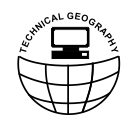Geographia Technica, Vol 9, Issue no. 2/2014, pp. 9-20
USE OF MULTISPECTRAL SENSORS WITH HIGH SPATIAL RESOLUTION FOR TERRITORIAL AND ENVIRONMENTAL ANALYSIS
Raffaella BRIGANTE, Fabio RADICIONI
ABSTRACT: The variations to which the land is subject caused by human activities that increasingly involve the natural environment make territorial planning necessary to ensure a sustainable organization of space that is beneficial to the community. The most changes concern both urban and natural areas. Having updated information on these changes is important if one wishes to analyze the relationships between human activities and the natural environment. Such information may be obtained by means of aerial and/or satellite images in GIS systems, into which different types of data are integrated for performing spatial analysis. The new satellites for remote sensing allow the acquiring of high-resolution images in several spectral bands which, combined together, provide information on land cover, such as vegetation or the presence of water. The applications are numerous: for example, it is possible to analyze the state of the vegetation in rural areas, or assess changes in the land using images from different time periods. This paper reports two territorial applications: the first concerning changes in land use in an urban area using high-spatial-resolution satellite and aerial imagery from different periods; the other regarding a coastal area in which the instantaneous shoreline has been detected. Algorithms for automatic detection of vegetation and water and automatic multispectral classification have been applied to these images.
Keywords: Environmental analysis, Land surveying, Remote sensing, GIS, satellite image

 Full article here
Full article here